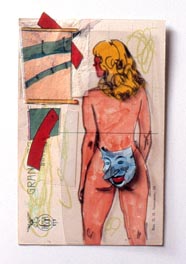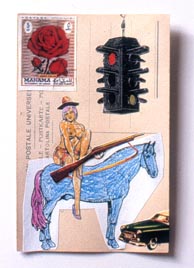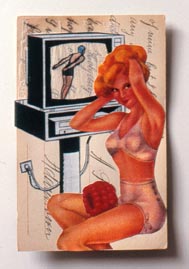M/E/A/N/I/N/G
Online
#2
Jane Hammond and
Raphael Rubinstein
Jane Hammond
Recently, I collaborated with poet Raphael Rubinstein on a book project. The project began in 2000 and culminated in the publishing of a limited edition artist book in the fall of 2002. The book contains four poems by Rubinstein which inspired the art within, the design and concept of the book, the covers, and slipcases that enclose it.
|
It's a very interactive collaboration and the arc of its development goes something like this: Ten or more years ago I heard Rubinstein read a poem he'd written titled "Six Sex." The poem consisted of six stanzas of six lines of six words of six letters. Inside that architecture it told a tale of a man who cavorted across Europe having various liaisons in Lisbon, Madrid, Dieppe, and twelve other six-lettered cities. I was enthralled by its form and content and the unique symbiosis of the two. I asked the poet if I could have "dibs" on the poem.
For all captions: Be Zany, Poised Harpists, Be Blue, Little Sparrows. 2002. Pictures by Jane Hammond. Poems by Raphael Rubinstein. Detail from "Six Sex," published by Dieu Donne Papermill, NYC.
I could backtrack here and say that years before this I had Raphael to my studio. When I discussed some of my own methods of working, he told me about a literary movement called Oulipo. So there was a shared interest in high-concept strategies, formal architecture and the territory where it interfaces with "self-driven" content.
When I was asked to do a project at Dieu Donne I immediately recalled "Six Sex." I called Raphael and asked if he had other poems in the series and in fact he had written what I shall call poems 1 through 7.
Although the book went through many visual manifestations I knew early on what I wanted to do conceptually speaking. I wanted to respond to each of these distinct pieces of writing with a very distinct artistic process. My bias against artist books in general is that a pattern is often established: picture, text, picture, text which is very repetitive, made even more so by the sequencing of pagination and 3/4 of the way through, I'm bored. Still the fact that a book is sequential is one of its great wonders—not to mention—that you turn the pages. It's like a hand-cranked film projector for an audience of one.
|
I liked the idea of using poems 2, 4 and 6 and I asked Raphael to write number 8. I think this spacing, rather than using, say, using poems 1 - 4, allowed for greater variability and emphasized the extreme difference between poem number 2, an ethereal haiku-like quickie, and poem number 8, an intricate and baroque opus.
I tried to design the architecture of the book around keeping separate things separate, letting them be utterly themselves, and trying to fuse with this architecture a sense of variability—I would call it a non-authorial sense of variability—a sense that the same poet could use the same architecture with completely different results. (Or maybe only somewhat different results.)
Much of my own work is about the confluence of the inside and the outside, the made and the found, the fictional and the factual. I'm also interested in thinking about thinking, which often leads to the interface of images and language.
This seems to me the most 50/50 collaborative think I've ever done. I'm kind of surprised about that because I'm not sure I'm so collaborative by nature. Perhaps because books naturally house difference—color and black and white, text and pictures, text and footnotes, etc, they allow for two minds in a way that would seem hard with a painting.
I don't know where the causes and effects begin and end.
One Plus One
It was sometime in the mid-‘90s that Jane Hammond heard me read the poem "Six Sex" at a temporarily empty storefront on LaGuardia Place in Manhattan where the publisher Geoffrey Young had organized a reading series. The poem was the sixth text in a sequence of poems that I had begun perhaps 10 years earlier, inspired by a Georges Perec poem that contained four stanzas or four lines each, with four four-letter words in each line.
|
After writing a similarly structured "4th power" poem, I went on to compose poems 1, 2, 3 and 5, which in the early ‘90s were published in the St. Marks Poetry Project Newsletter. Since each successive poem in the series became increasingly challenging, it was a few years before I attempted number 6, the poem that Jane responded to enthusiastically when she heard me read it, saying that she wanted "dibs" on it.
Years passed. I'd practically forgotten Jane's claim and the series languished. I couldn't imagine writing a 7th poem of seven seven-line, seven-word, seven letter stanzas. Impossible! Then, one day, Jane called me to say that Dieu Donné had invited her to do an artist's book and that she'd like to use "Six Sex" in it. Great. And that she also wanted poems 2 and 4. Even better. And poem 8—she wanted the book to count "2,4,6,8," as in a cheerleading yell. I immediately said yes to doing the book together, but I warned Jane that it might take me a little while to write the 8th poem. In fact, it would be more than a year before I completed it.
While Jane did not actively participate in the composition of the poem, I'm sure that were it not her invitation, I would never have written it. During the process of writing, which involved extracting a lexicon of 8-letter words from a tall stack of music reference books and the recesses of my own mind and a Web site that Jane's husband Craig McNeer pointed me to, I often reflected on the similarities between what I was doing and Jane's own artistic process, how we are both interested in using constrictive procedures for the playful difficulties they impose as well as the unexpected results they can produce.
I also enjoyed the unusual feeling of writing a poem more or less by commission, something that is rare for contemporary poets, and unprecedented for me. Knowing that Jane and Dieu Donné were waiting for the poem was not only flattering to my artistic ego, but also helped keep me going when it seemed impossible that I would ever find a way of getting to the next line of the poem. It's an aspect of the project that I wish could happen more often. One of the most valuable things about collaborations is that they can draw you out of the isolation that seems to accompany most artistic creation, at least in our society.
Once the poems were completed, Jane's turn came, and over the course of a further year I was able to watch how she responded to the poems, brilliantly conceiving a physical and conceptual framework for them, and working with the staff of Dieu Donné, who were also an important part of this collaborative project, to realize Be Zany Poised Harpists, Be Blue Little Sparrows. Along the way, I kept tweaking the 8th poem, "Active Octaves," and, when asked, offered my opinion about the structure of the book, though Jane always went her own way.
The spirit was simultaneously collaborative and autonomous, which allowed us to surprise each other throughout the process. Perhaps the most purely collaborative element is the title. Its syntactical and numerical structure, which mirrors the structure of the book, was conceived by Jane, while the actual wording was my doing.
It's perhaps too soon to say how Be Zany Poised Harpists, Be Blue Little Sparrows, which was only completed a few months ago, will affect me as a writer. At the same time, such collaborative projects seem for me at the moment to be the most interesting context for writing poems. I'm not ready, just yet, to go back to that empty writing room and the old illusion of autonomous creation.
Jane Hammond is a painter living in New York City, where she is represented by Galerie Lelong. She has had solo shows in New York, Stockholm, Amsterdam, Barcelona, Milan, Detroit, Chicago, Seattle and Kansas City. She is the recipient of the Louis Comfort Tiffany Foundation Grant, the Ludwig Vogelstein Foundation Grant in Painting, two New York State Council on the Arts Grants, the National Endowment for the Arts Fellowship and the Joan Mitchell Foundation Grant Award.
Raphael Rubinstein's books include The Basement of the Café Rilke, Postcards from Alphaville, Peintures Croisées and the forthcoming Polychrome Profusion: Selected Art Criticism, 1990-2002. He lives in New York City and is an editor at Art in America.
| Table Of Contents: |
| 01. |


